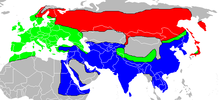
Back Sperber (Vogel) ALS Accipiter nisus AN باشق أوراسي Arabic باشق اوراسى ARZ Accipiter nisus AST Хъергъу AV Bildirçinçalan Azerbaijani بایاغی آتماجا AZB Бүҙәнә ҡарсығаһы Bashkir Ястраб-перапёлачнік Byelorussian
| Sparrowhawk | |
|---|---|

| |
| A male Eurasian sparrowhawk | |

| |
| A female Eurasian sparrowhawk | |
| Scientific classification | |
| Domain: | Eukaryota |
| Kingdom: | Animalia |
| Phylum: | Chordata |
| Class: | Aves |
| Order: | Accipitriformes |
| Family: | Accipitridae |
| Genus: | Accipiter |
| Species: | A. nisus
|
| Binomial name | |
| Accipiter nisus | |

| |
Breeding summer visitor Resident year-round Non-breeding winter visitor
| |

The sparrowhawk (Accipiter nisus) is a small bird of prey in the family Accipitridae. It has a wide distribution in Eurasia and north Africa.
The adult male sparrowhawk has a blue-grey back and wings. His chest and belly have thin orange stripes. Female and young sparrowhawks have brown backs and wings, with thin brown stripes. The female is up to 25% larger than the male. This is one of the biggest size differences in any bird species.
The sparrowhawk eats mostly small birds which live in woodland. It can be seen in any habitat and often hunts birds in town and city gardens. Male sparrowhawks eat smaller birds like tits, finches and sparrows. Females eat bigger birds like thrushes and starlings. They can kill birds weighing more than 500 grams (18 oz).
The sparrowhawk is seen in Europe, parts of Asia and parts of Africa. Birds that breed in the north migrate south for winter. Birds that live further south stay there, or fly shorter distances.
Sparrowhawks build a nest in woodland. The nest is up to 60 cm (2.0 ft) wide and made from twigs. The female lays four or five eggs with pale blue shells. The chicks hatch after 33 days and leave the nest after another 24 to 28 days.
The proportion of young sparrowhawks which survive to one year old is 34%. More young males die than young females. 69% of adults survive from one year to the next. The average lifespan is four years.
The number of sparrowhawks decreased in Europe in the 1950s. Chemicals to kill unwanted insects ("pesticides") were put on seeds before they were planted. Small birds ate the seeds and then sparrowhawks ate the small birds. The amount of chemicals in the food chain increased. This affected the sparrowhawks. Some were poisoned and others laid eggs with shells that were too thin. The shells broke before the chicks hatched. The pesticides were banned and the sparrowhawk population increased again. It is now one of the commonest birds of prey in Europe.
The sparrowhawk's hunting behaviour means people who own homing pigeons or keep birds for food may dislike it. Some people also blame the sparrowhawk for decreases in the numbers of smaller birds. Scientists have found that increased numbers of sparrowhawks did not reduce the numbers of birds living in farmland and woodland in the 1960s. Research in Scotland found that less than 1% of homing pigeons that died were killed by sparrowhawks.
People have used the Sparrowhawk for falconry (hunting using a bird of prey) for more than 500 years. It is difficult to train but brave. The sparrowhawk features in some old German myths. It is mentioned in a play by William Shakespeare and a poem by Ted Hughes.
- ↑ BirdLife International (2016). "Accipiter nisus". IUCN Red List of Threatened Species. 2016: e.T22695624A93519953. Archived from the original on 2009-01-04. Retrieved 2010-03-04.
